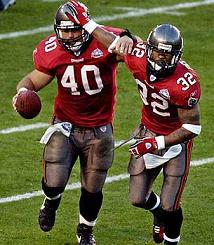|
|
 |
 The Tampa Tribune, published 27 January 2003
The Tampa Tribune, published 27 January 2003
Share and share alike. That's what Tampa Bay running backs were asked to do this season. That's asking a lot, considering how important ``getting into a rhythm'' is with backs.
Maybe that's why the running game was out of sync for most of the season. The running game that wasn't supposed to be good enough to get to the Super Bowl, let alone win it.
 A rushing attack that finished the season ranked 27th in the league, that at one point was rated below all but one of the other 31.
A rushing attack that finished the season ranked 27th in the league, that at one point was rated below all but one of the other 31.
A funny thing happened to Tampa Bay's ground game on the road to San Diego. It hit stride. Coach Jon Gruden's running-back-by-committee approach worked. In postseason, the Bucs offense was at its most balanced.
Starting running back Michael Pittman did his part. So did six-time Pro Bowl fullback Mike Alstott. Backup Aaron Stecker carried out his role.
``I think we do a great job,'' Pittman said. ``Mike runs the ball very well inside and out, and Aaron Stecker is kind of a slasher, very quick. And myself, I'm kind of a mixture of Mike and Stecker. If that's what we continue to do next year, that's what I'm all for. If it brings us another championship, I'll do it for the rest of my career.''
Pittman struggled to find his rhythm this season but led the team with 718 rushing yards on 204 carries. And his 59 receptions for 477 yards bolstered his per touch average to 4.5 yards. He saved his best game for last, rushing for a game-high 124 yards against Oakland. ``A lot of times in my career, I've had to share the ball,'' Pittman said.
``Out in Arizona, I was sharing the ball with Thomas [Jones], and in Tampa, I've been sharing it with Mike. Sometimes you get frustrated about it, but I think I did a great job running the ball. We've been criticized a lot, but you have to understand that Coach Gruden brought in a lot of players from different organizations. He put us all together, and we had to get to know each other.''
 Alstott led the team with seven touchdowns - five rushing, two receiving. His per-touch average was 4.4 yards. Alstott carried the biggest load in the divisional victory against San Francisco, rushing for 60 yards and two touchdowns in a 31-6 victory. ``There's a lot of heart in this unit,'' Alstott said. ``There's a lot of heart and a lot of character. This team never gives up.''
Alstott led the team with seven touchdowns - five rushing, two receiving. His per-touch average was 4.4 yards. Alstott carried the biggest load in the divisional victory against San Francisco, rushing for 60 yards and two touchdowns in a 31-6 victory. ``There's a lot of heart in this unit,'' Alstott said. ``There's a lot of heart and a lot of character. This team never gives up.''
Stecker had the Bucs' longest run of the season, a 59- yard dash against Minnesota on Nov. 3. Stecker set up a touchdown to give the Bucs a 17-0 lead, but he did much more. His run caused Gruden to ponder utilizing Stecker more in the running game. Two games later, Stecker had a career-high four carries against Atlanta, and he had four against Detroit. That's when the term running back by committee first came up. It boiled down to Gruden's finding the right matchups.
And that's when the criticism really took off, because many had their favorite and an argument why that player should handle the bulk of the carries. ``Maybe that's why this is so sweet,'' Alstott said. ``The things we had to overcome, a lot of adversity. This team's really new. I think we had 30- some odd new people. We implemented a new offensive strategy, basically revamped the whole offense with new players.''
It has taken some getting used to. Pittman admitted to frustration at times during the regular season, but later in the year, things began turning around. Credit goes to the offensive line, free of injuries and more comfortable in Gruden's offense. Credit goes to the entire running attack for hanging in there, knowing things have a way of working out. ``This is a brand-new offense, and it's going to take some time,'' Pittman said. ``I think as the time and the year went on, we got much better.''
|

|
|
| |
| |
|